The programmable power supply, or PPS, feature was added with the USB-C/Type-C power delivery 3.0 (PD3.0) specification (edn.net). This specification expanded on what was available with PD2.0. 2.0 which only supported fixed output voltages - 5V, 9V, 15V, or 20V - at a nominal 3A, but up to 5A for 100W. PD3.0 also supports up to 100W, but PD3.1 (usb.org) raises this ceiling to 240W with the introduction of 28V, 36V, and 48V output. The clear pathway forward is "more power" but the quality of the power is important, too.

USB PD2.0/3.0 basic characteristics. Source: Akyga (akyga.com).
These specifications are all improvements over the default USB-C power limit of 15W (5V@3A) and also for battery charging 1.2 (wikipedia.org), or BC1.2, which produces a maximum of 7.5W (5V@1.5A). It's not uncommon for USB 3.0 ports, using USB-A/Type-A, to provide only 2.5 to 4.5W (5V@0.5A-5V@0.9A). This is plenty of power for legacy devices such as keyboards and mice, and 4.5W is enough for external storage in most cases. For high-performance devices, however, more power is required. Thunderbolt 3's (wikipedia.org) nominal 15W can be expanded to 100W with USB-C PD, which is necessary to charge power-hungry devices.
It's not just about powering a device but about charging it, too. Using and charging a device at the same time requires bypass charging support but, moreover, these powerful devices often have advanced but delicate batteries. Improper charging can be wasteful and damaging, raising electrical costs and creating environmental impacts not only from power use but also e-waste disposal concerns. Batteries that are improperly charged will have reduced lifespan and may bulge and start fires. This is where PPS comes into play.
PPS allows finer voltage steps of 20mV to calibrate charging on-the-fly with understanding of the host device. This has various ranges such as 3.3V~22V at up to 5A. This ensures the highest level of charging efficiency which reduces heat output and is also ideal for battery lifespan. This is especially true for lithium-ion batteries that may have trickle charging (wikipedia.org) capabilities. Everything around us today is battery-powered, so it's important to have the right charger on hand. This is especially true if you are charging multiple devices at once, or are powering a device that has others downstream.

Full PD comparison, including PPS. Source: Kovol Inc (kovolinc.com).
Sabrent makes multiple chargers, hubs, and other devices that comply with the PD3.0 specification. We have more advanced products in development that also support this specification, including PPS, to give you the best and most reliable experience possible. We take power seriously and want both our products and your devices to have the fullest lifespan possible. For more information about USB power delivery, please check the sources listed above. You can also find more information on Qualcomm's proprietary Quick Charge (wikipedia.org) as a fast charging alternative.














